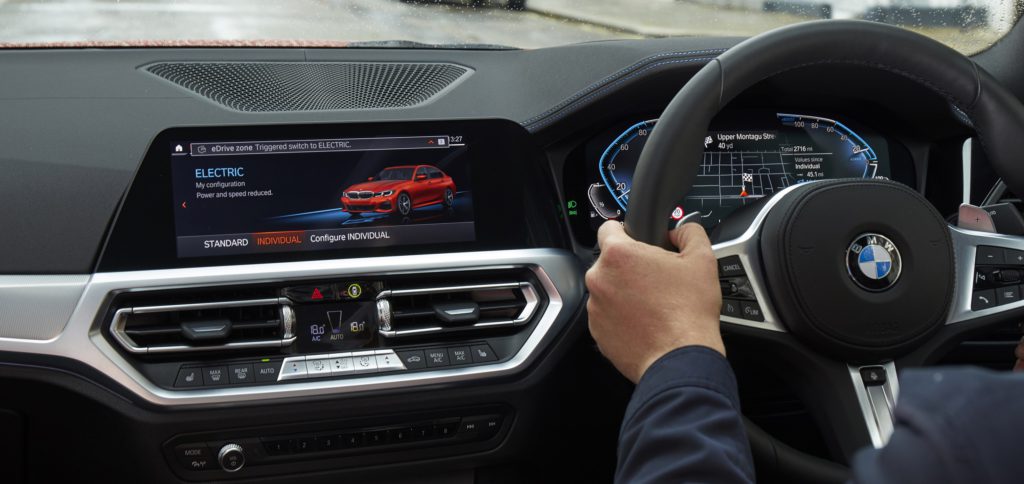BMW launches eDrive zones in UK
11 August 2020

11 August 2020
BMW has become the first carmaker to use a GPS geofencing system in the UK. The technology allows plug-in hybrids (PHEV) to automatically switch to pure-electric driving mode when entering one of the defined ′eDrive’ zones in London and Birmingham.
The launch of this system comes as more cities look to introduce low emission zones (LEZ). By utilising eDrive to automatically go electric in urban areas, BMW hopes to boost the attractiveness of electromobility for consumers.
Geofencing via GPS
Using geofencing technology via GPS within the vehicle’s navigation system, a BMW PHEV will be able to automatically switch to a purely electric driving mode. The eDrive zones in the two British cities are graphically highlighted on the vehicle’s navigation screen, allowing drivers to see their location.
The eDrive zones cover the same areas as the TFL Congestion Charge/ULEZ zone in London, and Birmingham’s planned Clean Air Zone, due to be implemented in 2021. Plans are in place to introduce the technology in additional cities across the UK and Ireland in the future. Meanwhile, Europe will see the system launch this summer, after 80 cities gave it the go-ahead in March.
Best of both worlds
With electric ranges of up to 86km, BMW argues its PHEVs are built with cities in mind, as they can complete most commutes using the electric portion of the drivetrain. The eDrive system allows for electric power to be automatically conserved if a journey passes through a LEZ, when the destination is entered into the vehicle’s navigation system. This leaves an efficient internal combustion engine to cover longer distances.
′This is the flexibility that customers want, as they make the transition to electromobility,’ said Pieter Nota, BMW board member for customer, brands and sales. ′A plug-in hybrid vehicle combines the best of two worlds: emission-free city-driving as well as long-distance capabilities.’
′We urge governments to prioritise PHEVs in order to encourage consumers to live a more sustainable lifestyle. BMW eDrive Zones technology supports customers to drive emission-free in London and Birmingham. It improves air quality in cities fast and reduces running costs for drivers. It’s win-win for everyone,’ Nota added.
The UK Government announced in 2018 that it would no-longer provide grants for PHEV models, and would instead concentrate funding on battery-electric vehicles (BEVs). Last year, it confirmed that these plans would not be reversed, leading to a dramatic fall in PHEV sales. The UK is also the only major market not to announce any incentive schemes to help its automotive industry as it attempts to recover from coronavirus (COVID-19) lockdowns and the resulting economic impact.
Just cars?
The system will be available as standard for PHEVs running the latest BMW Operating System 7.0. This includes the BMW 330e, 530e, 745e and X5 xDrive45e, with additional compatible models launching in the future. BMW eDrive is also available via a free over-the-air software update for existing customers with a compatible PHEV.
It is not just electric vehicles (EVs) contributing to the company’s electromobility goals however; BMW Group’s UK manufacturing locations are also playing their part. The Hams Hall plant, near Birmingham, assembles three-cylinder and four-cylinder petrol engines that power several BMW and Mini PHEVs. By the end of 2020, it is expected that one in five engines built by the company in the city will be destined for a PHEV, rising to around 25% next year.
At the Mini plant in Oxford, production of the brand’s first battery-electric vehicle (BEV) started earlier this year. At the end of July, the site hit a production milestone with 11,000 Mini Electric models built since the model launched in 2019. Autovista Group assessed the model’s strengths, weaknesses, opportunities and threats across the major European markets back in March.
The manufacturing group currently offers 14 EVs across its brand portfolio. The carmaker plans to increase this number to 25 by the end of 2023, with more than half of those models fully electric. In Europe, the group expects EVs will account for 25% of sales by 2021, a third by 2025 and half by 2030. The company aims to have more than seven million EVs on the roads in 10 years, with around two-thirds sporting a fully-electric drivetrain.